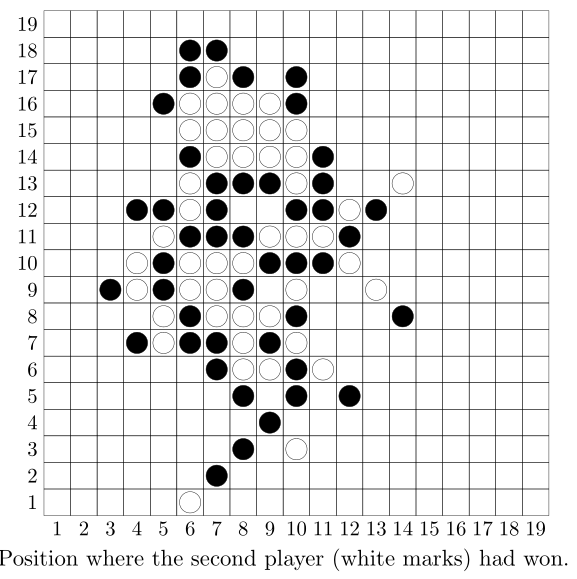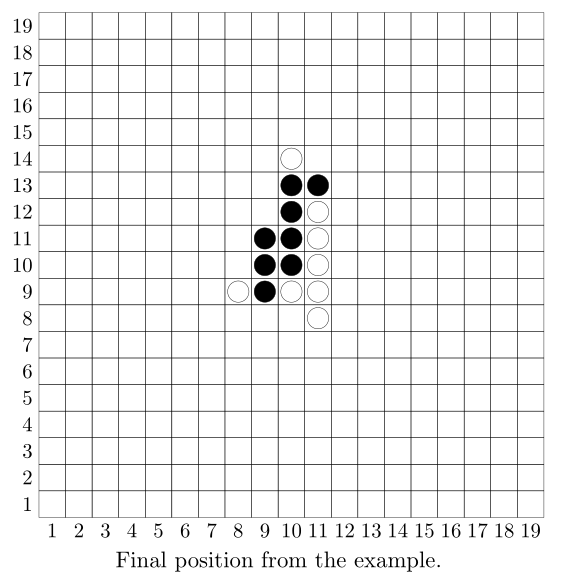 Рабочее место участника
Рабочее место участника
| Выбрать соревнование | Задачи | Послать решение | Результаты проверки | Статистика по задачам | Вопросы и ответы | Результаты соревнования | Состояние сервера | Изменить данные | Управление командой | Помощь |
 Задачи
Задачи
2225. Gomoku Игры
ИгрыИнтерактивные задачи
Олимпиадные задачи на английском языке

| 05/05/2015 | Занятие 24 (D) |
Ограничения: время – 2s/4s, память – 256MiB Ввод: интерактивная задача Вывод: интерактивная задача 
Послать решение Blockly Посылки Темы Где Обсудить (0)
This is an interactive problem.
Gomoku is a two-player game on a two-dimensional grid. Each cell of the grid can be either empty, contain
the first player’s mark (black), or contain the second player’s mark (white), but not both. Initially the
entire grid is empty. Two players make alternating moves, starting with the first player. At each move,
a player can put her mark into exactly one empty cell. The first player to have her five adjacent marks
in a single row wins. The winning row can be either vertical, horizontal or diagonal.

The players use a `19\ "xx"\ 19` grid in this problem. If the entire grid gets filled with marks but no player has
won, the game is declared a draw.
The first player uses the following strategy: as the first move, she puts her mark into the center cell of
the grid. At every other move, she picks such a move that maximizes the score of the resulting position.
In order to find the score of a position, the first player considers all possible places where the winning
combination might eventually form — in other words, all horizonal, vertical and diagonal rows of five
consecutive cells on the board (of course, they may overlap each other). If such a row contains both the
first player’s marks and the second player’s marks, it is disregarded. If such a row contains no marks, it
is disregarded as well. For each row with exactly `k` (`1\ ≤\ k\ ≤\ 5`) marks of the first player and no marks
of the second player, add `50^{2k-1}` to the score of the position. For each row with exactly `k` marks of the
second player and no marks of the first player, subtract `50^{2k}` from the score of the position. Finally, add
a random integer number between 0 and `50^2\ -\ 1` to the score. This random number is chosen uniformly.
In case when several moves of the first player have equal scores (such ties are quite rare because of the
random addition mentioned above), the first player picks the one with the smallest `x`-coordinate, and in
case of equal `x`-coordinates, the one with the smallest `y`-coordinate.
Your task is to write a program that plays the second player and beats this strategy.
Your program will play 100 games against the strategy described above, with different seeds of random
generator. Your program must win all these games.
Interaction protocol
On each step, your program must:
- Read numbers `x` and `y` from the input.
- If both these numbers are equal to `-1` then the game is over and your program must exit.
- Otherwise these numbers are the coordinates of the first player’s move (`1\ ≤\ x,y\ ≤\ 19`).
- Print the coordinates of the move of the second player, followed by line end. Don’t forget to flush the output buffer.
Sample input and output
In the example below the first player does not use the strategy from the problem statement. The
example is given only to illustrate the interaction format.
standard input
10 10 10 11 10 12 10 13 9 10 9 11 9 9 11 13 -1 -1
standard output
11 10 11 11 10 9 10 14 8 9 11 9 11 12 11 8

Note
There are many variations of Gomoku rules in the world. Please only consider the rules described in this problem statement.
 Начало
Начало